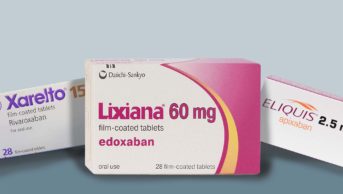
Mclean/Aflo Co., Ltd. / Alamy Stock Photo
After reading this article, you should be able to:
- Understand the therapeutic and practical benefits of direct oral anticoagulants (DOACs);
- Understand DOAC dosage calculations and factors affecting renal function;
- Explain the importance of ongoing monitoring and long-term support for patients receiving DOACs.
Initially launched in 2008 for primary prevention of post-operative venous thromboembolism (VTE), direct oral anticoagulants (DOACs) represent a major advancement in anticoagulation[1–4]. The number of licensed DOACs and indications has now increased to include treatment or recurrence of deep vein thrombosis, pulmonary embolism and thromboprophylaxis of stroke in patients with atrial fibrillation (AF)[2–11].
Compared with vitamin K antagonists, including warfarin, DOACs carry a lower risk for bleeding complications associated with anticoagulation (e.g. intracranial haemorrhage)[12–15]. DOACs also have a wider therapeutic index compared with warfarin; they are prescribed as fixed doses, have a predictable response and require less monitoring and infrequent changes of dosage.
These characteristics mean that a growing number of patients can now be anticoagulated. This has been incentivised by the Quality and Outcomes Framework and, from 2022/2023, by the Investment and Impact fund indicators[16,17].
However, the same comparative advantages of DOACs over vitamin K antagonists means there is a risk of practitioners adopting a ‘prescribe and forget’ approach, resulting in patients being on dangerous combinations of medicines and incorrect anticoagulant doses without suitable review[18]. While international normalised ratio monitoring is not required for DOACs, it is still necessary for patients to be regularly reviewed to ensure they remain on the correct dosage, tolerate the medicine well and adhere to their regimen. As with traditional anticoagulants, DOACs increase the risk of bleeding and this risk should be actively managed and reduced as far as possible.
This article explains the pharmacology of DOACs and how a risk-benefit assessment is made when initiating anticoagulation for patients with AF or atrial flutter. It also outlines the principles of effective monitoring and what pharmacists can do to ensure patients continue to obtain the full benefit of these drugs, while minimising bleeding risk.
Pharmacodynamic and pharmacokinetic profiles of DOACs
DOACs can be divided into two classes: direct thrombin inhibitors (e.g. dabigatran), and direct factor Xa inhibitors (e.g. apixaban, edoxaban and rivaroxaban; see Figure 1).
The coagulation cascade is a series of reactions involving coagulation factors that ultimately results in the formation of a blood clot. The DOACs directly inhibit one specific coagulation factor in the cascade, whereas warfarin prevents the coagulation process by suppressing the synthesis of several vitamin K-dependent coagulation factors.
All DOACs have differing bioavailability but are all rapidly absorbed in the upper gastrointestinal tract (see Figure 1). Peak blood levels are achieved within 1–2 hours of ingestion and relatively short half-lives (compared with warfarin) mean they have a faster onset and offset of action[19]. The benefit of short half-lives is that most bleeding episodes can be stopped by withdrawing the DOAC and taking supportive measures (antidotes are also now available for dabigatran, apixaban and rivaroxaban). However, this also means that omitted doses will rapidly expose the patient to risk of thromboembolism[19].
Contraindications for DOACs
Either anticoagulation itself, or specific use of DOACs, may be contraindicated in certain patients (see Table 1). Specific patient groups of note are discussed further below.
Initiating anticoagulant treatment
Before a patient starts anticoagulation, a risk-benefit assessment must be made where the underlying stroke risk is balanced against the risk of bleeding associated with anticoagulation. Initial tests are conducted to establish baseline measurements and to identify any clinical considerations warranting specialist referral. Initial weight and blood pressure measurements are required, alongside ongoing anticoagulation monitoring blood tests (e.g. coagulation screen, full blood count, liver function test and creatinine levels; see Table 2). Note that weight measurement is important for both calculating dosing (see below) and assessment of renal function.
There are various tools available for assessing stroke and bleeding risk.
Assessing stroke risk
The National Institute for Health and Care Excellence (NICE) recommends using the CHA2DS2-VASc stroke risk score to assess stroke risk in people with:
- symptomatic or asymptomatic paroxysmal, persistent or permanent AF;
- atrial flutter;
- a continuing risk of arrhythmia recurrence after cardioversion back to sinus rhythm or catheter ablation[20].
An annual stroke risk assessment is also recommended and should form part of the discussion with the healthcare professional. This discussion should ensure that the patient understands the purpose of anticoagulation and is sufficiently informed to be able to balance the benefits against risk of bleeding[16,17,20].
Assessing bleeding risk
The HAS-BLED score for major bleeding risk has been used to assess risk of bleeding from anticoagulation in patients with AF[21]. However, in 2021, NICE recommended switching to the ORBIT score, owing to greater accuracy in predicting absolute bleeding risk compared with other tools[20,22,23].
Bleeding risk factors should be reviewed and action taken to reduce them. These include:
- Uncontrolled hypertension (systolic blood pressure >160mmgHg), which is associated with a higher risk of intracranial haemorrhage;
- concurrent medication (prescribed or purchased over the counter), including antiplatelets, selective serotonin reuptake inhibitors (SSRIs) and non‑steroidal anti‑inflammatory drugs (NSAIDs), which increase the risk of bleeding. It may be possible to stop or reduce doses, or start gastroprotection therapy — for example, proton pump inhibitors (PPIs);
- Excessive alcohol consumption (more than eight units per week), which is associated with an increased risk of bleeding. Patients should be advised to drink only in moderation and not binge drink;
- Reversible causes of anaemia[19,20,24–28].
Discussing the results of risk assessment
The results of the assessments (CHA2DS2-VASc and ORBIT) for stroke and bleeding risk must be discussed with the patient with consideration of their individual circumstances (e.g. comorbidities, individual preferences, medical history). For most patients, the benefits of anticoagulation will outweigh their risk of bleeding. A high ORBIT score on its own should not be used to deny patients the benefits of anticoagulation[20]. Instead, measures should be taken to reduce bleeding risk factors as much as possible[26].
The risk of unprovoked bleeding and bruising when using DOACs (e.g. nosebleeds, haematuria, oral mucosal or vaginal bleeding) should specifically be discussed as this is more common with anti Xa DOACs than warfarin[29]. While these types of bleeding may be considered minor by healthcare professionals, they can be distressing for patients and may result in reduced adherence. Typical measures to treat and reduce recurrence (e.g. for nose bleeds — lean forward and pinch nose) should be taken[30].
Some patients may raise the fact that they have experienced falls, and view this as a reason not to initiate anticoagulation. Although often a concern for patients, risk of falls is not a contraindication to initiating oral anticoagulation and the healthcare professional can help patients to make an informed assessment of comparative risk. For instance, a patient with an annual stroke risk of 5% [CHADS2-VASc score 2–3] would need to fall 295 times for the fall risk to outweigh the stroke reduction benefit of warfarin[31].
Helping the patient to understand and quantify the risks and benefits of anticoagulation can result in increased confidence when deciding whether to accept treatment when risk is low and will prompt discussion of risk reduction when risk is high.
Consideration of comorbidities
Comorbidities and the specific circumstances of the patient need to be considered both at initiation of treatment but also as a component of long-term monitoring and review. Pre-existing conditions will influence the initial risk-benefit assessment but there are many cases where new conditions present after DOAC therapy has been started. For example, patients with major gastrointestinal resections or bypass, especially proximal to colon, will need to be assessed by a specialist (e.g. a haematologist) as absorption may be reduced. In this case, warfarin could be a better choice[32].
Similarly, an assessment will need to be made for patients with cancer. As active cancer has been an exclusion factor for most phase III DOAC trials, clinical data is limited; however, a recent meta-analysis comparing use of DOACs with warfarin indicated improved outcomes, with a trend towards fewer major bleeding events. In this respect, it is more important to consider the specific cancer and its propensity to bleeding, as well any drug–drug reactions with chemotherapy. The same principles apply when considering any other possible drug–drug reactions. Specific drug-drug interactions are available in the European Heart Rhythm Association guidance document (see ‘Useful resources’).
Obesity is also a frequent complicating factor in patients with heart disease[33]. As with patients with cancer, clinical trial data for overweight patients is limited, and establishing the optimal DOAC dose is complex and must be approached cautiously (see Figure 2)[19].
Calculating renal function to inform dosing
When a decision has been made to commence anticoagulation, the patient’s renal function needs to be accurately calculated to inform the DOAC dosage. This should be reviewed periodically and rechecked with up-to-date blood tests and weight measurements (see Table 3 and Table 4). Changes in the patient’s weight or overall health condition will necessitate measurements to check the dose remains appropriate. If the patient’s renal function/weight/risk factors have changed, it may be appropriate to adjust the dose. For example, a few weeks after hospital discharge following heart failure admission, an assessment will be necessary as the patient’s weight and renal function may have stabilised at a new level.
To calculate renal function (creatinine clearance [CrCl]; see Figure 2), the Cockcroft-Gault equation and actual body weight should be used[12–15,34]. The estimated glomerular filtration rate should not be used as it is known to increase risk of bleeding events because of overestimating renal function, especially in older patients with low body weight/body mass index (BMI)[35].
It is important that the renal function is calculated correctly to allow optimal dosing [35]. Care should be taken to ensure the use of actual body weight and for veryoedematous patients (e.g. patients with heart failure), the weight before they became fluid overloaded should be used[36].
As previously discussed, extremes in body mass present a complexity in DOAC dosing. There are limited data on appropriate dosing in such patients and the CG equation may not be accurate for extremes of bodyweight[35]. For patients <50kg, the actual body weight should be used. For obese patients >120kg or BMI >40, web-based applications (e.g. MD+Calc) should be used alongside actual bodyweight to calculate the CG CrCl. This is because creatinine is a muscle breakdown product and, in obese people, the excess weight will result in an inaccurate result with a CG equation. Incorporating height can allow for the calculation of a modified CrCl using the CG equation. If the two calculations using actual and modified estimates produce different doses, a clinical judgement will have to be made over which dose to prescribe[35].
In all instances, pharmacists should ensure patients are prescribed the correct dose to obtain the full anticoagulation benefit without unnecessary bleeding risk. For an example dosing decision-making algorithm, see ‘Useful resources’[37,38].
Adverse reactions
Bleeding is the primary side effect of DOACs, but there are other adverse reactions that may require management. Patients who develop haematuria or gastrointestinal bleeding should be managed under usual pathways for bleeding from that site and referred for investigation if appropriate[39,40]. It should also not be assumed that bleeding can be attributed only to the DOAC; it can be the case that bleeding triggered by anticoagulation reveals an underlying problem that would have otherwise gone undetected (e.g. haematuria may be a sign of bladder cancer rather than a side effect of anticoagulation).
Gastrointestinal reactions (e.g. indigestion/dyspepsia with dabigatran) may settle on their own in one to two weeks but, if unresolved, may require treatment with a H2 antagonist/PPI[2-4],or patients could be switched to an alternative DOAC.
Use of dabigatran can cause diarrhoea in some patients. This may take several weeks to become apparent but can gradually worsen to such an extent that patients become incontinent. It can take several weeks or months after stopping dabigatran for patients to recover[2,3,12].
Pruritus without rash can develop in some patients on anti Xa DOACs. This can sometimes be improved by switching to a different DOAC, especially if the patient is eligible for a different anti Xa at a reduced dose, or switching to dabigatran or warfarin[29]. If patients develop a skin rash, the culprit drug should be withdrawn and specialist advice sought on an alternative replacement anticoagulant[29].
Fatigue, malaise and psychological disturbances (e.g. panic attacks) have also been reported with the anti Xa DOACs and may require a change of anticoagulant — this may not be resolved by simply switching to a different anticoagulant from the same class[29].
Ongoing monitoring
There have been anecdotal and published reports of erroneous DOAC dosing in hospital/outpatient discharge summaries[41]. Doses must be checked — this process should include downloading the patient’s most recent blood test results. For previously acutely unwell patients, it may be necessary to repeat blood tests and weight measurement as there may be dramatic changes over a short period of time.
All patients should have a review two to four weeks after starting a DOAC to check for side effects, bruising/bleeding, adherence and to schedule the next review. Rechecking of ureas and electrolytes/ weight and calculating CrCl, liver function tests and full blood count may be necessary if specified by the initiating clinician or indicated by changing clinical state. If started on the DOAC elsewhere; for example, secondary care, a risk assessment should be undertaken by GP staff as the initiator may not have had access to full patient history/medical record.
The risk-benefit of DOACs can vary over time, as can the dose required; therefore ongoing active monitoring of DOACs is essential — passive monitoring is inappropriate.
Regular ongoing follow up and reassessment is required at least annually (see Table 3 and Table 4).
Patient education and supporting adherence
As DOACs are often used for long-term treatment, pharmacists have an important role in encouraging adherence. Unlike warfarin, the stable dosing and wider therapeutic index means that patients with poor adherence will not be as visible[42]. Many clinical commissioning groups produce local counselling checklists to ensure that key points are covered with the patient/family/carers when initiating a DOAC. A template produced by South East London Integrated Medicines Optimisation Committee provides a good example of this (see ‘Useful resources’).
Patient preferences that encourage adherence should also be considered when establishing DOAC treatment strategies. For instance, it may be more convenient for the patient to take once-daily or twice-daily medication if this aligns with any other medication regimens they receive or coincides with a regular visit from a carer. For patients requiring adherence aids, dabigatran should be avoided because it is hygroscopic.
All DOACs, except dabigatran, do not need to be swallowed whole, making them suitable for crushing for patients with swallowing difficulties or with enteral tubes[2–11].
Summary
DOACs have many pharmacological advantages over vitamin K antagonists, but it is important that they are prescribed appropriately and regularly reviewed. Extremes of weight are a complicating factor for DOACs and should be thoroughly considered when calculating renal function and establishing the correct dosage. Pharmacists have an essential role in helping patients to understand the risks and benefits of anticoagulation; ensuring that patients remain on the correct dose, thereby minimising their risk of bleeding; and improving patients’ ability to safely benefit from these medicines over the long term.
Useful resources
- An anticoagulant dosing decision making algorithm produced by the West Hampshire Clinical Commissioning Group;
- Direct Oral Anticoagulant (DOAC) Initiation and Monitoring Guidance Template produced by South East London Integrated Medicines Optimisation Committee. The template contains guidance on initiation and monitoring and a counselling checklist to support patient education and adherence;
- 2021 European Heart Rhythm Association Practical Guide on the use of non-vitamin K antagonist oral anticoagulants in patients with atrial fibrillation.
- 1New oral anticoagulants for stroke prevention in atrial fibrillation. Pharmaceutical Journal. 2016. doi:10.1211/pj.2016.20201755
- 2Pradaxa 150 mg hard capsules. Electronic medicines compendium. 2022.https://www.medicines.org.uk/emc/product/4703 (accessed Oct 2022).
- 3Pradaxa 110 mg hard capsules. Electronic medicines compendium. 2022.https://www.medicines.org.uk/emc/product/6229 (accessed Oct 2022).
- 4Pradaxa 75 mg hard capsules. Electronic medicines compendium. 2022.https://www.medicines.org.uk/emc/product/6228/smpc (accessed Oct 2022).
- 5Lixiana 60 mg film coated tablets – summary of product characteristics . Electronic medicines compendium. 2022.https://www.medicines.org.uk/emc/product/6905/smpc (accessed Oct 2022).
- 6Lixiana 30mg Film-Coated Tablets. Electronic medicines compendium. 2022.https://www.medicines.org.uk/emc/product/6906/smpc (accessed Oct 2022).
- 7Eliquis 5 mg film-coated tablets. Electronic medicines compendium. 2022.https://www.medicines.org.uk/emc/product/2878/smpc (accessed Oct 2022).
- 8Eliquis 2.5 mg film-coated tablets. Electronic medicines compendium. 2022.https://www.medicines.org.uk/emc/product/4756/smpc (accessed Oct 2022).
- 9Xarelto 20mg film-coated tablets. Electronic medicines compendium. 2022.https://www.medicines.org.uk/emc/product/2793/smpc (accessed Oct 2022).
- 10Xarelto 15mg film-coated tablets. Electronic medicines compendium. 2022.https://www.medicines.org.uk/emc/product/2794/smpc (accessed Oct 2022).
- 11Xarelto 10 mg film-coated tablets. Electronic medicines compendium. 2022.https://www.medicines.org.uk/emc/product/6402/smpc (accessed Oct 2022).
- 12Connolly SJ, Ezekowitz MD, Yusuf S, et al. Dabigatran versus Warfarin in Patients with Atrial Fibrillation. N Engl J Med. 2009;361:1139–51. doi:10.1056/nejmoa0905561
- 13Patel MR, Mahaffey KW, Garg J, et al. Rivaroxaban versus Warfarin in Nonvalvular Atrial Fibrillation. N Engl J Med. 2011;365:883–91. doi:10.1056/nejmoa1009638
- 14Granger CB, Alexander JH, McMurray JJV, et al. Apixaban versus Warfarin in Patients with Atrial Fibrillation. N Engl J Med. 2011;365:981–92. doi:10.1056/nejmoa1107039
- 15Giugliano RP, Ruff CT, Braunwald E, et al. Edoxaban versus Warfarin in Patients with Atrial Fibrillation. N Engl J Med. 2013;369:2093–104. doi:10.1056/nejmoa1310907
- 16Quality and Outcomes Framework (QOF). NHS Digital. 2022.https://digital.nhs.uk/data-and-information/data-tools-and-services/data-services/general-practice-data-hub/quality-outcomes-framework-qof (accessed Oct 2022).
- 17Network Contract Directed Enhanced Service – Investment and Impact Fund 2022/23 summary. NHS England. 2022.https://www.england.nhs.uk/publication/network-contract-directed-enhanced-service-investment-and-impact-fund-2022-23-summary/ (accessed Oct 2022).
- 18‘Worrying’ number of patients prescribed risky anticoagulant drug combinations. Pharmaceutical Journal. 2019. doi:10.1211/pj.2019.20206950
- 19Steffel J, Collins R, Antz M, et al. 2021 European Heart Rhythm Association Practical Guide on the Use of Non-Vitamin K Antagonist Oral Anticoagulants in Patients with Atrial Fibrillation. EP Europace. 2021;23:1612–76. doi:10.1093/europace/euab065
- 20Atrial fibrillation: diagnosis and management. National Institute for Health and Care Excellence. 2021.https://www.nice.org.uk/guidance/ng196 (accessed Oct 2022).
- 21Pisters R, Lane DA, Nieuwlaat R, et al. A Novel User-Friendly Score (HAS-BLED) To Assess 1-Year Risk of Major Bleeding in Patients With Atrial Fibrillation. Chest. 2010;138:1093–100. doi:10.1378/chest.10-0134
- 22O’Brien E, Simon D, Thomas L, et al. The ORBIT bleeding score: a simple bedside score to assess bleeding risk in atrial fibrillation. Eur Heart J 2015;36:3258–64. doi:10.1093/eurheartj/ehv476
- 23ORBIT Bleeding Risk Score for Atrial Fibrillation. MD+CALC. 2022.https://www.mdcalc.com/calc/10227/orbit-bleeding-risk-score-atrial-fibrillation (accessed Oct 2022).
- 24O’Donnell M, Xavier D, Liu L, et al. Risk factors for ischaemic and intracerebral haemorrhagic stroke in 22 countries (the INTERSTROKE study): a case-control study. Lancet 2010;376:112–23. doi:10.1016/S0140-6736(10)60834-3
- 25Tai F, McAlindon M. Non-steroidal anti-inflammatory drugs and the gastrointestinal tract. Clin Med (Lond) 2021;21:131–4. doi:10.7861/clinmed.2021-0039
- 26Proton Pump Inhibitors (PPIs) and anticoagulants Advisory guidance on when to initiate a PPI for gastro-protection. West Essex Clinical Commissioning Group. 2022.https://westessexccg.nhs.uk/your-health/medicines-optimisation-and-pharmacy/clinical-guidelines-and-prescribing-formularies/01-gastro-intestinal-system/3340-ppi-advisory-guidance-on-when-to-iniaite-for-gastro-protection/file (accessed Oct 2022).
- 27Ballard H. The hematological complications of alcoholism. Alcohol Health Res World 1997;21:42–52.https://www.ncbi.nlm.nih.gov/pubmed/15706762
- 28Lip G, Nieuwlaat R, Pisters R, et al. Refining clinical risk stratification for predicting stroke and thromboembolism in atrial fibrillation using a novel risk factor-based approach: the euro heart survey on atrial fibrillation. Chest 2010;137:263–72. doi:10.1378/chest.09-1584
- 29APIXABAN DABIGATRAN, EDOXABAN AND RIVAROXABAN FOR NON VALVULAR ATRIAL FIBRILLATION (AF). Buckingham Healthcare NHS Trust. 2021.https://www.bucksformulary.nhs.uk/docs/Guideline_313FM.pdf?UNLID=5089264572022324111917 (accessed Oct 2022).
- 30Frequently asked questions (FAQs) concerning Direct Acting Anticoagulants (DOACs) for primary care practitioners in South East London. South East London Integrated Medicines Optimisation Committee. 2022.https://selondonccg.nhs.uk/wp-content/uploads/dlm_uploads/2021/09/DOAC-FAQs-Sept-2020-FINAL.pdf (accessed Oct 2022).
- 31Man-Son-Hing M, Nichol G, Lau A, et al. Choosing Antithrombotic Therapy for Elderly Patients With Atrial Fibrillation Who Are at Risk for Falls. Arch Intern Med. 1999;159:677. doi:10.1001/archinte.159.7.677
- 32Hakeam HA, Al-Sanea N. Effect of major gastrointestinal tract surgery on the absorption and efficacy of direct acting oral anticoagulants (DOACs). J Thromb Thrombolysis. 2017;43:343–51. doi:10.1007/s11239-016-1465-x
- 33Lassale C, Tzoulaki I, Moons KGM, et al. Separate and combined associations of obesity and metabolic health with coronary heart disease: a pan-European case-cohort analysis. European Heart Journal. 2017;39:397–406. doi:10.1093/eurheartj/ehx448
- 34British National Formulary. 85th ed. London: : BMJ Group and Pharmaceutical Press 2022.
- 35DOACs (Direct Oral Anticoagulants) monitoring. Specialist Pharmacy Service. 2022.https://www.sps.nhs.uk/monitorings/doacs-direct-oral-anticoagulants-monitoring/ (accessed Oct 2022).
- 36Calculating Renal Function (Creatinine Clearance) When Monitoring Direct Oral Anticoagulants (DOACs) For Safe and Effective Dosing Of Patients. South East London Area Prescribing Committee. 2019.https://selondonccg.nhs.uk/wp-content/uploads/dlm_uploads/2021/09/Calculating-renal-function-for-DOACs-Sept-2019-FINAL.pdf (accessed Oct 2022).
- 37Prescribing medicines in renal impairment: using the appropriate estimate of renal function to avoid the risk of adverse drug reactions. Medicines and Healthcare products Regulatory Agency. 2019.https://www.gov.uk/drug-safety-update/prescribing-medicines-in-renal-impairment-using-the-appropriate-estimate-of-renal-function-to-avoid-the-risk-of-adverse-drug-reactions#examples-of-harm-related-to-incorrect-renal-impairment-calculations (accessed Oct 2022).
- 38Vinogradova Y, Coupland C, Hill T, et al. Risks and benefits of direct oral anticoagulants versus warfarin in a real world setting: cohort study in primary care. BMJ. 2018;:k2505. doi:10.1136/bmj.k2505
- 39Urological cancers – recognition and referral. National Institute for Health and Care Excellence. 2021.https://cks.nice.org.uk/topics/urological-cancers-recognition-referral/ (accessed Oct 2022).
- 40Gastrointestinal tract (lower) cancers – recognition and referral. National Institute for Health and Care Excellence. 2021.https://cks.nice.org.uk/topics/gastrointestinal-tract-lower-cancers-recognition-referral/ (accessed Oct 2022).
- 41Moudallel S, Cornu P, Dupont A, et al. Determinants for under- and overdosing of direct oral anticoagulants and physicians’ implementation of clinical pharmacists’ recommendations. British Journal of Clinical Pharmacology. 2021.https://bpspubs.onlinelibrary.wiley.com/doi/full/10.1111/bcp.15017 (accessed Oct 2022).
- 42Medicines adherence: involving patients in decisions about prescribed medicines and supporting adherence. National Institute for Health and Care Excellence. 2009.https://www.nice.org.uk/guidance/cg76 (accessed Oct 2022).


